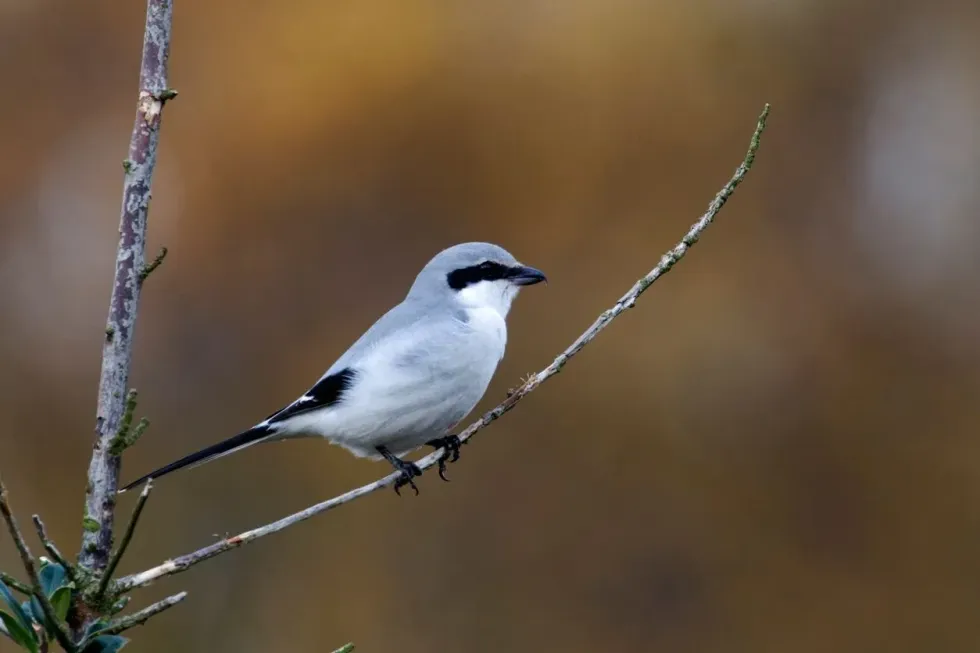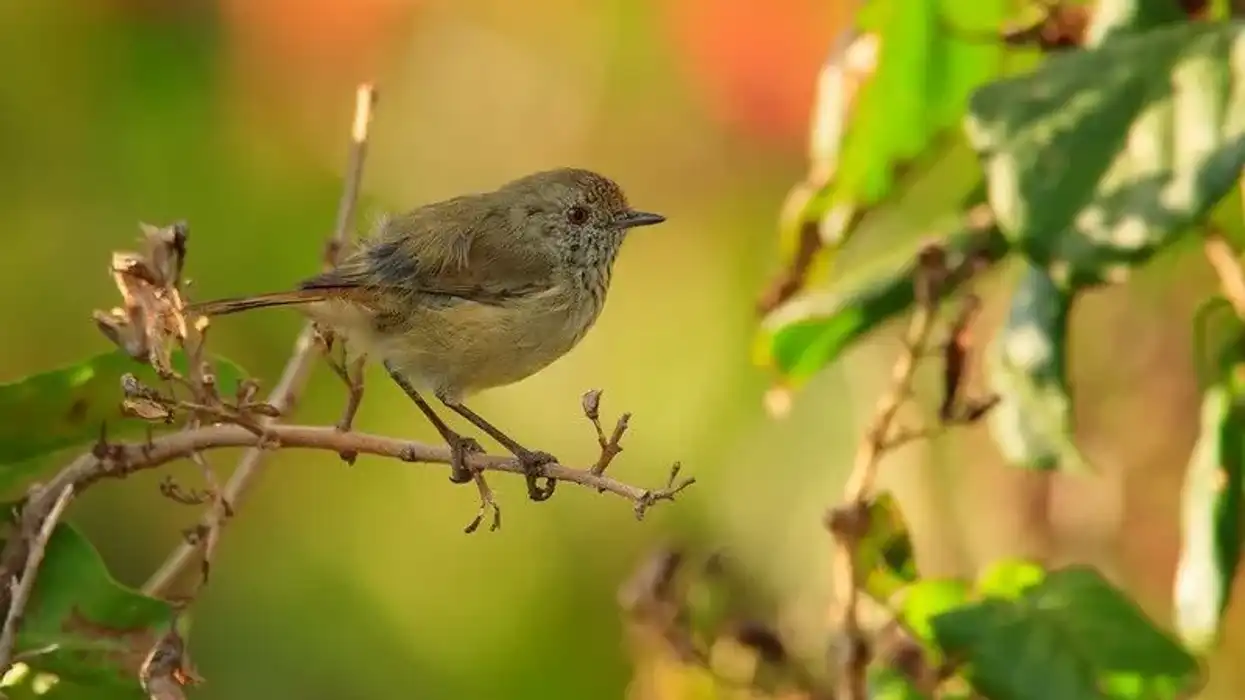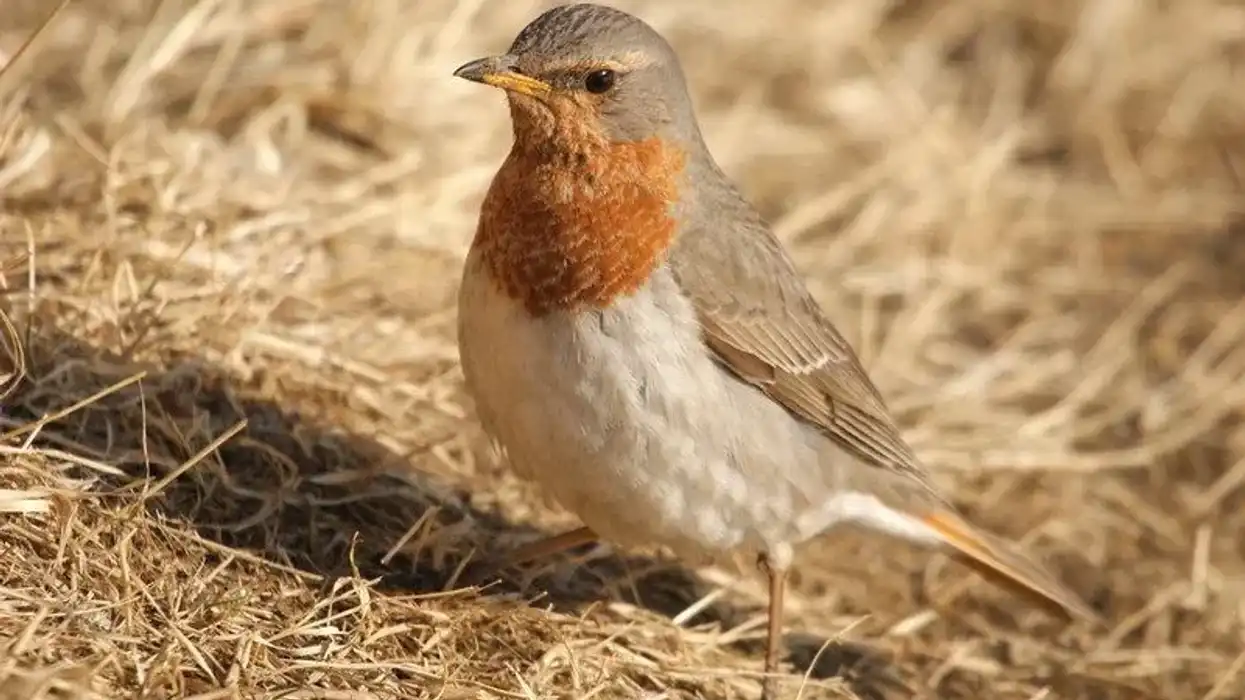The Great Grey Shrike (Lanius excubitor) is a passerine (songbird) species of the shrike family Laniidae.
A medium-sized bird with a stocky body and a rather medium-length tail, it is unique among passerines in having gruesome carnivorous tendencies.
Although the birds have an innocent and delicate appearance, they hardly show any mercy when it comes to treating their prey. Since the bird's legs and feet are not suited for tearing the prey, it resorts to impaling the prey upon thorns or barbed wire, followed by ripping the prey into bite-sized pieces with its hooked beak.
With an overall pearl gray plumage and an assassin-like black mask around the eyes, the fact that the first part of the shrike's Latin name (Lanius) translates to butcher is no surprise!
Great Grey Shrikes are the largest in the European shrike family, with distribution across Europe, Asia, and North Africa. They usually breed in open areas that could be shrubland or an open forest.
During the wintering season, these birds typically migrate to temperate regions in southern locations. However, populations in the mountainous regions of Central Asia usually travel downslope rather than migrate southwards.
The birds are short-distance migrants with movements usually triggered by reduced prey populations and hence, scarcity of food. These shrikes are quite vocal and use a variety of calls to communicate.
Do you find these predatory shrikes interesting? Then read on to know more about them!
You may also like to know about other shrike species such as the Northern Shrike and loggerhead shrike
Great Grey Shrike Interesting Facts
What type of animal is a Great Grey Shrike?
The Great Grey Shrike (Lanius excubitor) is a species of songbird. It belongs to the shrike family Laniidae.
What class of animal does a Great Grey Shrike belong to?
The Great Grey Shrikes belong to the class of birds (class Aves).
How many Great Grey Shrikes are there in the world?
The global population size of the Great Grey Shrikes is unknown. Even though the International Union for Conservation of Nature (IUCN) Red List of Threatened Species reports a decreasing population trend, the species has quite an extensive geographical range.
Where does a Great Grey Shrike live?
The breeding grounds of the Great Grey Shrikes comprise open and semi-open areas such as shrublands, mixed and coniferous forests, meadows, pastures, farmlands, and field hedges. They usually breed in the subarctic and temperate zones. Outside the breeding season, their habitat primarily consists of meadows.
What is a Great Grey Shrike's habitat?
The Great Grey Shrike (Lanius excubitor), a non-endemic bird (Lanius excubitor) has quite an extensive breeding range throughout Europe, Asia, and North Africa. Subspecies are spread across various Eurasian and African countries, with vagrants reported in northern and western Europe, Britain, South Korea, Borneo, Iceland, and parts of the Mediterranean region. During winter, the birds migrate southwards.
These shrikes prefer low to sparse vegetation with suitable perches provided by bushes, small groves, isolated trees, fences, and electric wires. They usually avoid higher elevations, dense forests that do not offer hunting grounds, and low grasslands with no nesting and lookout opportunities.
Who does Great Grey Shrike live with?
Despite being territorial, these shrikes tend to live in small groups of six or more pairs. The breeding season finds pairs becoming more solitary. However, groups of birds may gather together outside the breeding season, spending time calling, chattering, and interacting through flight displays.
How long does a Great Grey Shrike live?
In the wild, Great Grey Shrikes have an average lifespan of four years, with the oldest recorded individual being 12 years of age.
How do they reproduce?
The breeding season of Great Grey Shrikes begins in March and extends up to April or May. Mating is preceded by elaborate courtship displays through physical gestures and a variety of calls.
Even though these birds are socially monogamous and form a strong pair bond in the breeding season, the wintering season may find some pair bonds loosening followed by the selection of a new mate.
These birds prefer to breed in scattered groups comprising six or more individuals. Breeding pairs build nests in about one or two weeks, with the nest located at least 3.3 ft (1 m) above the ground.
Both males and females participate in nest-building, with males procuring most of the nest materials. The nests are usually located in a thorny bush or tree, often in a central position of the male's territory such that convenient perches are available for keeping an eye out on the territory.
The female bird lays a clutch of three to nine eggs that are incubated for 16 days to three weeks solely by the female.
During this time, the male mate takes care of the female's feeding requirements so that the latter can focus on incubating the eggs. The hatchlings are born blind and naked, taking about two to three weeks to fledge and three to six weeks to become entirely independent.
As the juvenile birds mature, both the male and the female parents participate in food provisioning and make sure to take extra care of the weak fledglings.
What is their conservation status?
As per the International Union for Conservation of Nature (IUCN) Red List of Threatened Species, the Great Grey Shrike is a species of Least Concern with a globally decreasing population trend.
Great Grey Shrike Fun Facts
What does Great Grey Shrike look like?
The Great Grey Shrike is a medium-sized bird with pearl-gray upper parts. A black mask extends from the beak, past the eyes, to the ear coverts. The cheeks, chin, and stripe above the eyes are white. The wings are black with white tufts, and the shoulder feathers are white.
The medium-length tail is black with a pointed tip and white ends. The underparts are usually tinged gray or white, and the breast is comparatively darker than the rest of the underparts. The legs are feet are black.
Males and females are almost of the same coloration and size. Females, however, tend to have a brown tinge to their plumage but otherwise have the same overall color pattern as males. The fledglings are similar to females, having overall grayish-brown plumage with pastel yellow markings and barrings on the upper parts.

How cute are they?
The stout build and medium size of the Great Grey Shrike do lend the bird a cute and adorable look. However, the bird's appearance is quite deceptive given its highly carnivorous tendencies and dastardly techniques to kill insects, reptiles, amphibians, small mammals, and birds that make up its diet.
How do they communicate?
Great Grey Shrikes are quite the vocal birds. Both the female and male birds use a variety of calls, including courtship calls, alarm calls, prey attracting calls, and submission calls.
Warning sounds consist of warbles and whistles, with the whistling becoming raspier and shriller for larger intruders or predators. Alarm sounds are characterized by a harsh call, with the call becoming faster and higher as the bird becomes more excited.
Duets between mates or communication between males and females comprise soft whistles. Shrikes are smart enough to mimic the songs of other songbirds in order to attract songbird prey.
Besides vocalizations, shrikes use body gestures to communicate. For example, encounters with predators and preparation to attack prey include bobbing, twisting, and rapid up and down flipping of the tail.
Other gestures displayed by the bird include fluttering, quivering, and flashing movements, particularly in response to predators. Quivering and fluttering of the wings are common when males and females of breeding pairs communicate.
Aggression towards members of the same species is expressed by fluffing feathers. These shrikes are also known to use scent and ultraviolet light to detect the location and abundance of prey.
How big is a Great Grey Shrike?
Great Grey Shrikes range in length between 8.6-10.2 in (22-26 cm) with a wingspan of about 11.8-14.2 in (30-36 cm). The bird is slightly larger than the Northern Shrike (Lanius borealis) native to Siberia and North America.
How fast can a Great Grey Shrike fly?
An estimate of the flight speed range of the Great Grey Shrike is not available. Generally, this bird flies in a heavy and undulating pattern except while attacking prey when the flight becomes determined in a straight direction.
How much does a Great Grey Shrike weigh?
A Great Grey Shrike has a weight range of 1.69-2.85 oz (48-81 g). It is slightly heavier than the Northern Shrike of Siberia and North America.
What are the male and female names of the species?
Male and female shrikes do not have any distinct names.
What would you call a baby Great Grey Shrike?
A baby shrike would be called a hatchling, fledgling, or simply chick.
What do they eat?
Great Grey Shrikes are carnivorous birds with a diverse diet. However, their dietary preferences also depend on their habitat and the availability of food sources.
Animals that serve as food for these birds include insects such as beetles, crickets, grasshoppers, bees, wasps, and small mammals and birds like voles, mice, sparrows, juncos, siskins, chickadees, and European starlings. These shrikes may occasionally prey on frogs and lizards.
Are they dangerous?
While the shrikes pose no known danger to humans, the carnivorous birds are deadly predators in the wild and employ brutal ways to crush and kill their prey.
Would they make a good pet?
These shrikes are wild birds with a strictly carnivorous diet. Hence, it is not advisable to keep them as pets.
Did you know...
The first description of the Great Grey Shrike was given by Carl Linneaus in 1758 in his book Systema Naturae. The common Engish name shrike refers to the shrill call of the bird and is derived from the Old English scríc, meaning shriek.
The average territory size of Great Grey Shrikes is about 0.15 sq. mi (0.4 sq. km). However, shrikes can travel through a range thrice as much as their territory size with seasonal migrations to wintering and breeding grounds.
These shrikes display courtship feeding behavior during which the male bird presents a food item to its potential mate. Moreover, males maintain food caches to attract females.
What animal eats shrikes?
Known predators of shrikes include crows, raptors, little owls, and other mammals and birds.
Are shrikes birds of prey?
The shrike is no less than hawks, eagles, and other birds of prey. They extensively hunt both vertebrates and invertebrates, impaling the prey on thorns or barbed wire and tearing apart pieces with their hooked beak.
Here at Kidadl, we have carefully created lots of interesting family-friendly animal facts for everyone to discover! For more relatable content, check out these Lilac-Crowned Amazon Facts and Thick-billed Raven Facts pages.
You can even occupy yourself at home by coloring in one of our free printable Exotic Birds Coloring Pages.









